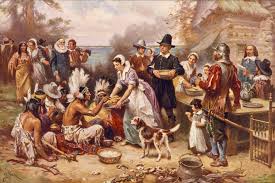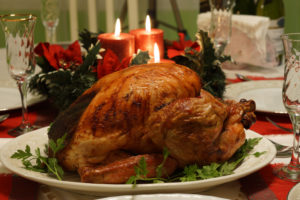In September 1620, a small ship called the Mayflower left Plymouth, England, carrying 102 passengers—an assortment of religious separatists seeking a new home where they could freely practice their faith and other individuals lured by the promise of prosperity and land ownership in the New World. Only half of the Mayflower’s original passengers and crew lived to see their first New England spring.
Squanto, a member of the Pawtuxet tribe, taught the Pilgrims, weakened by malnutrition and illness, how to cu ltivate corn, extract sap from maple trees, catch fish in the rivers and avoid poisonous plants. After the Pilgrims’ first corn harvest proved successful, a celebratory feast that lasted for three days, was organized. While no record exists of the historic banquet’s exact menu, the Pilgrim chronicler Edward Winslow wrote in his journal that Governor Bradford sent four men on a “fowling” mission in preparation for the event, and that the Wampanoag guests arrived bearing five deer.
ltivate corn, extract sap from maple trees, catch fish in the rivers and avoid poisonous plants. After the Pilgrims’ first corn harvest proved successful, a celebratory feast that lasted for three days, was organized. While no record exists of the historic banquet’s exact menu, the Pilgrim chronicler Edward Winslow wrote in his journal that Governor Bradford sent four men on a “fowling” mission in preparation for the event, and that the Wampanoag guests arrived bearing five deer.
Historians have suggested that many of the dishes were likely prepared using traditional Native American foods and cooking methods. Because the Pilgrims had no oven, the meal did not feature pies, cakes or other desserts, which have become a hallmark of contemporary celebrations.
In 1621, the Plymouth colonists and Wampanoag Indians shared this autumn harvest feast that is acknowledged today as one of the first Thanksgiving celebrations in the colonies. For more than two centuries, days of thanksgiving were celebrated by individual colonies and states. It wasn’t until 1863, in the midst of the Civil War, that President Abraham Lincoln proclaimed a national Thanksgiving Day to be held each November.
In many American households, Thanksgiving centers on cooking and sharing a bountiful
 meal with family and friends. Turkey is a Thanksgiving staple, so ubiquitous it has become all but synonymous with the holiday. Nearly 90 percent of Americans eat the bird—whether roasted, baked or deep-fried— according to the National Turkey Federation. Other New World foods that have become the tradition include stuffing, mashed potatoes, cranberry sauce and pumpkin pie. Since we are the melting pot of the world, friends and family often share foods from their heritage that were celebratory in their country and family. What Old World foods can be found at your Thanksgiving table, i.e. strudel, pierogis, or maybe ravioli?
meal with family and friends. Turkey is a Thanksgiving staple, so ubiquitous it has become all but synonymous with the holiday. Nearly 90 percent of Americans eat the bird—whether roasted, baked or deep-fried— according to the National Turkey Federation. Other New World foods that have become the tradition include stuffing, mashed potatoes, cranberry sauce and pumpkin pie. Since we are the melting pot of the world, friends and family often share foods from their heritage that were celebratory in their country and family. What Old World foods can be found at your Thanksgiving table, i.e. strudel, pierogis, or maybe ravioli?
Information gathered from history,com, the National Turkey Federation, and Mary Lynn Crowley (University of Akron’s cultural foods professor).